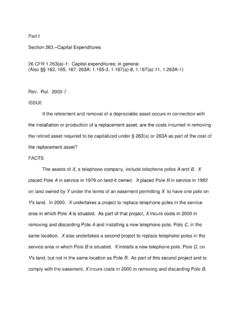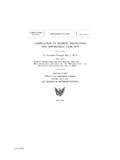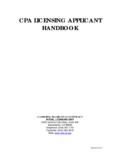Transcription of THE WANKEL ROTARY ENGINE 7.1 A Different Approach to …
1 261. CHAPTER 7. THE WANKEL . ROTARY ENGINE . A Different Approach to the Spark-Ignition ENGINE The reciprocating internal combustion ENGINE has served mankind for over a century, and will continue to do so for the foreseeable future. The WANKEL ROTARY ENGINE , a much more recent development, is said to have been conceived in its present form in 1954 (ref. 2). An implementation of the ROTARY ENGINE used in the 1990 Mazda RX-7. automobile and its turbocharger are shown in Figures (a) and (b). As of 1987, over million WANKEL engines had been used in Mazda automobiles (ref. 6). The ROTARY ENGINE has a host of advantages that make it a formidable contender for some of the tasks currently performed by reciprocating engines.
2 The piston in a four- stroke-cycle reciprocating ENGINE must momentarily come to rest four times per cycle as its direction of motion changes. In contrast, the moving parts in a ROTARY ENGINE are in continuous unidirectional motion. Higher operating speeds, ease of balancing, and absence of vibration are a few of the benefits. The high operating speeds allow the ENGINE to produce twice as much power as a reciprocating ENGINE of the same weight. It has significantly fewer parts and occupies less volume than a reciprocating ENGINE of comparable power. With all these advantages, why are there so few WANKEL engines in service? part of the answer lies in the reciprocating ENGINE 's remarkable success in so many applications and its continuing improvement with research.
3 Why change a good thing? Manufacturing techniques for reciprocating engines are well known and established, whereas production of ROTARY engines requires significantly Different tooling. It must be admitted, however, that the ROTARY ENGINE has some drawbacks. A major problem of the WANKEL automobile ENGINE is that it does not quite measure up to the fuel economy of some automotive reciprocating SI engines. It is the judgment of some authorities that it does not offer as great a potential for improvement in fuel economy and emissions reduction as reciprocating and gas turbine engines. However, although the ROTARY ENGINE may never dominate the automotive industry, it is likely to find applications where low weight and volume are critical, such as in sports cars, general aviation, and motorcycles.
4 262. While the ROTARY ENGINE may not enjoy the great success of reciprocating engines, it is worthy of study as an unusual and analytically interesting implementation of the familiar Otto cycle. Even the present success of this latter-day Otto ENGINE should serve as an inspiration to those who search for novel ways of doing things. This chapter is a tribute to Felix WANKEL and those who are helping to develop this remarkable ENGINE . ROTARY ENGINE Operation Figure shows a cross-section of a ROTARY ENGINE . The stationary housing encloses a moving triangular rotor that rotates with its apexes in constant contact with the housing inner surface. Air and combustion gases are transported in the spaces between the rotor and the housing.
5 The rotor rides on an eccentric that is an integral part of a shaft, as shown in the dual rotor crank shaft of Figure (a). The housing and rotor of a ROTARY ENGINE designed for aircraft application are shown in Figure (b). The operation of the WANKEL ENGINE as an Otto-cycle ENGINE may be understood by following in Figure the events associated with the counterclockwise movement of a gas volume isolated between the housing and one of the rotor flanks. The air-fuel mixture may be supplied, by a conventional carburetor, through the intake port labeled I in Figure (a). As the shaft and rotor turn, the intake port is covered, trapping a fixed mass of air and fuel (assuming no leakage). This is analogous to the gas mass captured within the cylinder-piston volume by closure of a reciprocating ENGINE intake valve.
6 As the rotor continues to turn, the captured (crosshatched) volume contained 263. between the rotor and housing decreases, compressing the air-fuel mixture [ part (b)]. When it reaches the minor diameter, the active mixture volume is a minimum corresponding to the volume at top center in the reciprocating ENGINE . One or more spark plugs, as indicated at the top of each housing, initiate combustion, causing rapid rises in pressure and temperature [ part (c)]. The hot, high-pressure combustion gas [ part (d)] transmits a force to the eccentric through the rotor. Note that, during the 264. 265. power phase, the line of action of the force F provides a counterclockwise torque acting about the shaft axis. As the rotation proceeds, the expanding gases drive the rotor until the exhaust port is exposed, releasing them [ part (e)].
7 The exhaust process continues as the intake port opens to begin a new cycle. This port overlap is apparent in the lower volume shown in part (b). In summary, each flank of the rotor is seen to undergo the same intake, compression, ignition, power, and exhaust processes as in a four-stroke-cycle reciprocating Otto ENGINE . All three flanks of the rotor execute the same processes at equally spaced intervals during one rotor rotation. Hence three power pulses are delivered per rotation of the rotor. Because there are three shaft rotations per rotor rotation, the WANKEL ENGINE has one power pulse per shaft rotation. Thus it has twice as many power pulses as a single- cylinder four-stroke-cycle reciprocating ENGINE operating at the same speed, a clear advantage in smoothness of operation.
8 This feature of one power pulse per shaft rotation causes many people to compare the WANKEL ENGINE with the two-stroke-cycle reciprocating ENGINE . ROTARY ENGINE Geometry The major elements of the ROTARY ENGINE the housing and the rotor are shown in cross-section in Figure The housing inner surface has a mathematical form known as a trochoid or epitrochoid. A single-rotor ENGINE housing may be thought of as two parallel planes separated by a cylinder of epitrochoidal cross-section. Following the notation of Figure , the parametric form of the epitrochoid is given by x = e cos 3 + Rcos [ft | m] ( ). y = e sin 3 + R sin [ft | m] ( ). where e is the eccentricity and R is the rotor center-to-tip distance. For given values of e and R, Equations ( ) give the x and y coordinates defining the housing shape when is varied from 0 to 360 degrees.
9 The rotor shape may be thought of as an equilateral triangle, as shown in Figures and (flank rounding and other refinements are discussed later in the chapter). Because the rotor moves inside the housing in such a way that its three apexes are in constant contact with the housing periphery, the positions of the tips are also given by equations of the form of Equations ( ): x = e cos 3 + R cos( + 2n*/3) [ft | m] ( ). y = e sin 3 + R sin( + 2n*) [ft | m] ( ). where n = 0, 1, or 2, the three values identifying the positions of the three rotor tips, each separated by 120 . Because R represents the rotor center-to-tip distance, the 266. motion of the center of the rotor can be obtained from Equations ( ) by setting R = 0.
10 The equations and Figure indicate that the path of the rotor center is a circle of radius e. Note that Equations ( ) and ( ) can be nondimensionalized by dividing through by R. This yields a single geometric parameter governing the equations, e/R, known as the eccentricity ratio. It will be seen that this parameter is critical to successful performance of the ROTARY ENGINE . The power from the ENGINE is delivered to an external load by a cylindrical shaft. The shaft axis coincides with the axis of the housing, as seen in Figure A second circular cylinder, the eccentric, is rigidly attached to the shaft and is offset from the shaft axis by a distance, e, the eccentricity. The rotor slides on the eccentric. Note that the axes of the rotor and the eccentric coincide.







